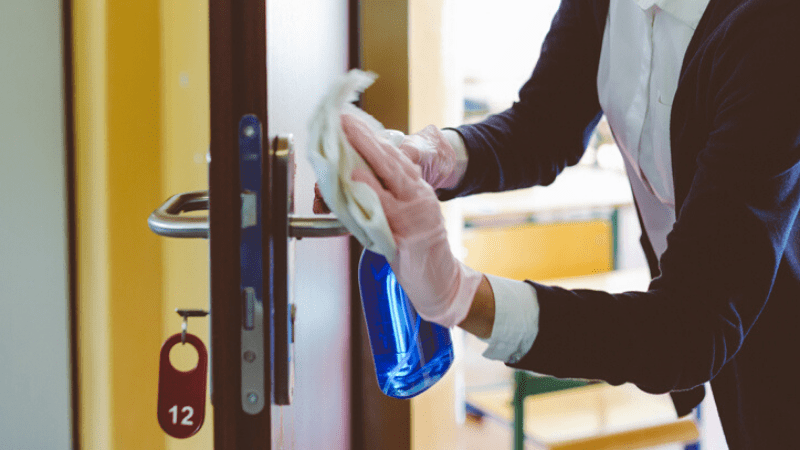As districts begin to plan for the possibility of reopening in the fall, our heads spin with questions. Will it be a blend of in-class and remote learning? How will social distancing work? Will there be fewer students? One thing’s for sure. We want our school environments to be as germ-free as possible, which begs another slew of questions. What is the difference between cleaning, disinfecting, and sanitizing? Which items need to be cleaned? And how often? Which products should we use? How can we use them safely?
The Centers for Disease Control and Prevention published guidance about opening schools safely. The guidance clearly defines and offers guidelines about how and when to clean, disinfect, and sanitize.
But, what’s the difference between cleaning, disinfecting, and sanitizing?
Cleaning works by using soap and water to physically remove germs and dirt from surfaces or objects. Cleaning doesn’t kill germs. But by removing them, it lowers their numbers and the risk of spreading infection.
Disinfecting works by using chemicals to kill germs on surfaces or objects. Disinfecting does not clean dirty surfaces, but by killing germs on a surface after cleaning, it can further lower the risk of spreading infection.
Sanitizing lessens the number of germs on surfaces or objects to levels that are considered safe according to public health standards. This process can be accomplished by either cleaning or disinfecting.
Know how to clean and disinfect properly and safely.
So how exactly do you clean and disinfect properly?
Before you start, put on a pair of gloves. These powder-free nitrile gloves from Kimberly Clark can be thrown away when you’re done. Or you can designate a pair of reusable gloves, like these Ambitex rubber gloves, for COVID-19 cleaning. Wash the gloves with soap and water and allow them to dry thoroughly between cleanings. Always wash your hands after you take your gloves off. In addition to wearing gloves, make sure you have good ventilation, especially when using chemicals.
As a general rule, clean first. Cleaning with soap and water will physically reduce the number of germs and dirt on the surface.
Then, disinfect. Disinfecting with chemicals kills germs on surfaces. You can use wipes, like these Lysol Disinfecting Wipes , sprays like Brighton Professional™ Surface Disinfectant and Deodorizing II Spray, or a liquid disinfectant cleaner, like Clorox Healthcare Hydrogen Peroxide Cleaner Disinfectant. Here are Six Steps for Safe and Effective Disinfectant Use recommended by the Environmental Protection Agency.
Pay particular attention to frequently touched surfaces.
We’re still learning about the COVID-19 virus, including how it spreads and how long the virus lives on surfaces. Below is a list of items that should be cleaned and disinfected at least after each class session. Depending on how many children are in each classroom, and how much space they are using, more frequent cleaning and disinfecting will likely be required.
- desks
- chairs
- tables
- door handles
- light switches
- countertops
- phones
- keyboards
- remote controls
- toilets
- faucets
- sinks
- handrails
- elevator buttons
- any shared items or devices
For electronics—such as tablets, touch screens, keyboards, and remote controls—always read product labels, and follow the manufacturer’s instructions for cleaning and disinfecting. Many products recommend keeping surfaces wet for a period of time (see product labels for contact times). Afterward, dry the surface of the electronics thoroughly. As an alternative, consider putting a wipeable cover on electronics. If possible, assign each child their own electronic device so that they are the only ones handling them.
Implement a frequent handwashing protocol.
The best way to prevent the spread of germs is to wash your hands often with soap and water for 20 seconds, especially after touching surfaces or objects that have been touched by others. Always use soap and water if your hands are visibly dirty, and especially after using the bathroom, blowing your nose, coughing, or sneezing.
Try this Soothing Aloe Vera Softsoap. If soap and water are not readily available (and your hands are not visibly dirty), use a hand sanitizer that contains at least 60% alcohol, like these Perk™ Instant Hand Sanitizers. Cover all surfaces of your hands and rub them together until they feel dry. Build in a hand-washing break every hour or so.
Need Cleaning and Disinfecting Products for Your School?
From soap and hand sanitizer to disinfecting cleaners, Staples has all the products you need for a safe return to school. You can even connect with an expert member of the Staples team to help you decide which combination of products is right for your school.
Learn More About Cleaning & Disinfecting Products From Staples

